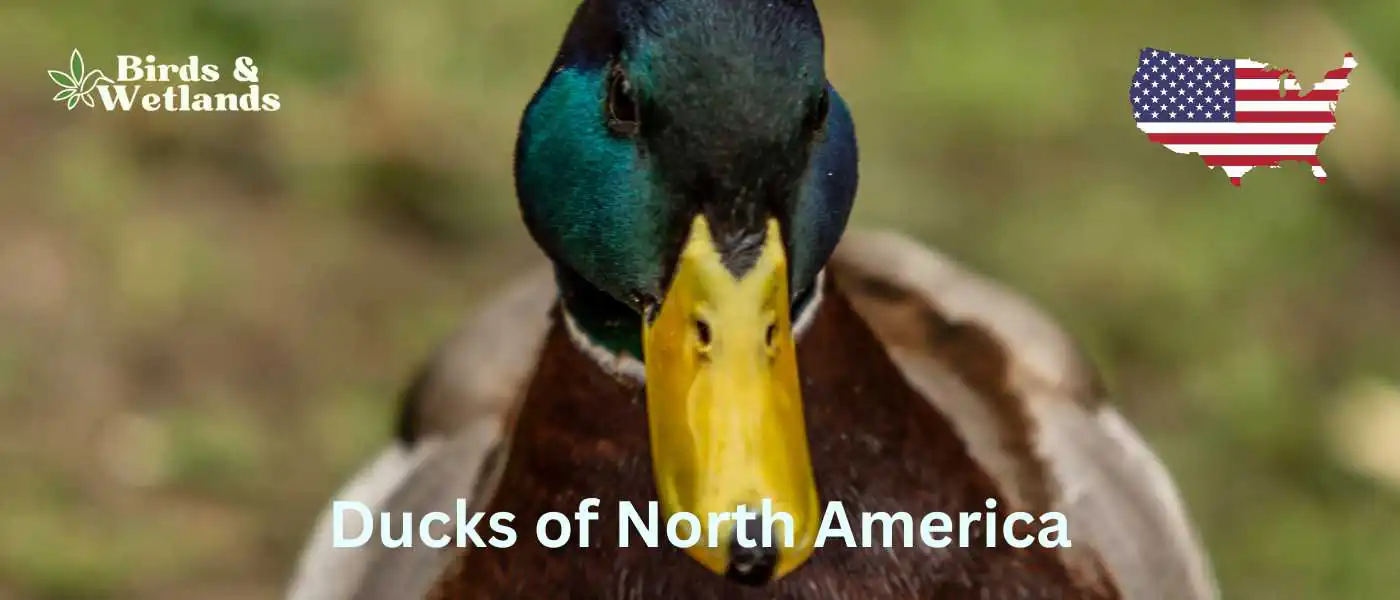North America is home to a diverse and fascinating array of duck species, which can be found in various habitats such as lakes, rivers, ponds, and wetlands. These waterfowl play an essential role in their ecosystems by controlling insect populations, dispersing plant seeds, and forming part of the food chain for other animals like birds of prey and aquatic mammals.
Among the many duck species native to North America, the mallard duck is one of the most commonly recognized. With its striking green head, brown body, and white stripes on the wings, it is easily identifiable and can be seen in many parts of the continent.
As a dabbling duck, it feeds close to the surface of the water by tipping up and upending. Other notable duck species include the American black duck, which resembles the female mallard in coloration but has darker plumage, and the ring-necked duck, known for its pointed head, distinctive grey bill with a white band, and striking yellow eyes.
Duck enthusiasts and birdwatchers can find a wealth of information about the various duck species native to North America by exploring online resources, photograph galleries, and participating in local field trips or organized birdwatching events.
Understanding and appreciating these remarkable waterfowl will inspire a deeper connection to nature and the conservation of these vital creatures and their habitats.
Types of Ducks in North America
North America is home to a diverse array of duck species, belonging to various sub-groups such as Dabbling Ducks, Diving Ducks, Sea Ducks, Stiff-Tailed Ducks, and Whistling Ducks. These ducks come in different shapes, sizes, and colors, boasting unique characteristics and habitats.
Dabbling Ducks
Dabbling Ducks are known for feeding at the water’s surface and typically have a diverse diet of aquatic plants, insects, and seeds. They can easily tip up to forage in shallow water. Some notable species of dabbling ducks include the American Black Duck, American Wigeon, Gadwall, Blue-winged Teal, and Cinnamon Teal.
Diving Ducks
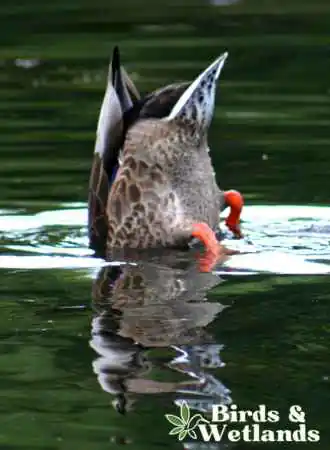
Diving Ducks, as their name implies, dive into the water to forage for food. They have a diet that mainly consists of fish, aquatic plants, and invertebrates. Several species of diving ducks found in North America include the Ring-necked Duck, Lesser Scaup, Bufflehead, and Canvasback.
Sea Ducks
Sea Ducks are adapted to marine environments and primarily inhabit coastal areas. They dive deep underwater, foraging for fish, mollusks, and crustaceans. Common North American Sea Ducks include the Common Eider, Harlequin Duck, and the Long-tailed Duck.
Stiff-Tailed Ducks
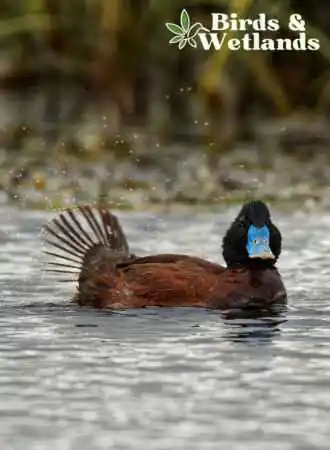
Stiff-Tailed Ducks are characterized by their unique, spiky tail feathers, which they often hold upright when at rest. They mainly inhabit freshwater habitats and feed on aquatic plants, insects, and small fish. The Ruddy Duck is the most common stiff-tailed duck species in North America.
Whistling Ducks
Whistling Ducks are named after their distinctive whistling calls. They are often found in wetlands and have a diet that includes seeds, aquatic plants, and invertebrates. The most common species of whistling ducks in North America are the Black-bellied Whistling Duck and the Fulvous Whistling Duck.
Habitats and Distribution
Ducks in North America inhabit a variety of ecosystems, making their habitats incredibly diverse. The following subsections will provide an overview of some of the most common habitats for these waterfowl.
Wetlands
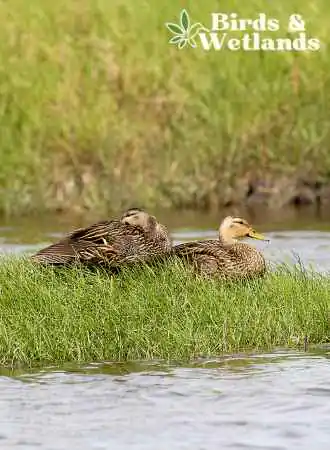
Wetlands serve as essential habitats for many duck species, offering a rich supply of food and nesting sites. This environment typically supports numerous invertebrates, fish eggs, and aquatic plants that ducks rely on for sustenance. Wetlands across North America host a wide range of duck species, including the Mottled Duck. Wetland restoration efforts, such as those in California’s Central Valley, have also influenced the distribution of white-fronted geese and dabbling ducks over the years.
Lakes and Ponds
Ducks inhabit a variety of lakes and ponds throughout North America, from small, isolated sites to vast, interconnected water systems. These habitats provide ample opportunities for feeding, nesting, and refuge from predators. Ducks living in lakes and ponds, have access to diverse food sources such as aquatic plants, small fish, and invertebrates.
Coastal Areas
Many duck species prefer shallow wetlands near coastal bodies of water, which provide unique foraging opportunities, nesting sites, and protection from predators. Some ducks, like the Bufflehead, thrive in these coastal habitats in the northern United States, Canada, and Alaska.
River Systems
Rivers and their accompanying tributaries provide important habitat for ducks in North America, providing essential resources and connecting different ecosystems. Ducks can take advantage of river systems’ varied landscapes, such as sandbars and oxbow lakes for nesting and feeding.
River systems also serve as vital stopover points during migration, offering resting and feeding opportunities before continuing to their final destinations.
Breeding and Migration Patterns
Nesting Behavior
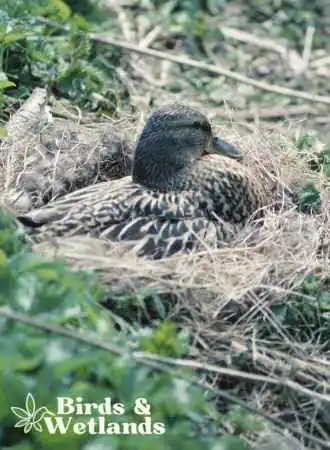
Ducks in North America exhibit a variety of nesting behaviors, depending on their species. Mallards, for example, are the most widespread and abundant ducks in North America, with an estimated 19 million breeding birds (Cornell Lab of Ornithology). These ducks typically create nests in tall grass or other vegetation near water, where they lay their eggs and raise their young.
Mating Systems
North American ducks utilize different mating systems. Some ducks, like the American black duck, have dark feathers and can be identified by their yellow bills and legs. These ducks often engage in monogamous breeding pairs, usually forming partnerships during the winter and maintaining them throughout the breeding season.
Other species of ducks, like the mallard, have more complex mating systems that include both monogamy and promiscuity. Mallards often form pairs during the winter months, but males may also seek out additional mating opportunities with other females during the breeding season.
Migration Routes
Many North American duck species participate in long-distance migrations as they move between their breeding and wintering grounds. These migrations typically span from breeding ranges in the United States and Canada to wintering areas in Central and South America. Ducks and geese follow ancient pathways known as flyways on their epic journeys.
There are four major waterfowl migration flyways in North America: the Atlantic Flyway, Mississippi Flyway, Central Flyway, and Pacific Flyway. Ducks’ choice of flyway depends on their species and breeding range. Within each flyway, waterfowl can travel thousands of miles round-trip throughout the course of a single migration season.
Conservation Efforts
Conservation of ducks in North America has become increasingly important due to habitat loss and other factors impacting their populations. Numerous organizations, government agencies, and communities are actively working to protect and restore critical habitats to ensure the survival of these waterfowl species.
Protected Areas
One of the major efforts in duck conservation involves the establishment and maintenance of protected areas. These areas, often in the form of wildlife refuges and preserves, provide essential habitats for ducks and other waterfowl species. For instance, the Ducks Unlimited organization has conserved more than 15 million acres of waterfowl habitats across North America since its inception in 1937.
Protected areas, such as the Prairie Pothole Region, also known as “America’s duck factory,” play a vital role in providing nesting grounds for a significant proportion of ducks in North America. Organizations like Ducks Unlimited are highly involved in the conservation of these regions, providing valuable scientific expertise and financial support for their protection.
Species Recovery Programs
Species recovery programs focus on addressing the specific needs of endangered and threatened duck species in North America. The Ecology and Conservation of North American Sea Ducks is an example of ongoing research and collaboration to address the challenges faced by sea duck species in the region. Such programs aim to bolster population numbers by improving nesting success, addressing diseases, and mitigating the impacts of human activities on their habitats.
Community Involvement
Community involvement plays a significant role in the success of duck conservation initiatives. By engaging in habitat restoration projects, participating in local conservation events, and supporting organizations like Ducks Unlimited, communities across North America can directly contribute to the protection of vital waterfowl habitats.
Furthermore, community-led education programs and campaigns help raise awareness of the importance of waterfowl conservation and motivate individuals to take action in their local areas. This collaborative approach to conservation is crucial for the long-term survival of duck populations in North America.
Duck Watching Tips
North America is home to a diverse range of duck species, making it a popular destination for birdwatchers and nature enthusiasts alike. To make the most of your duck-watching experience, consider these helpful tips and recommendations.
Best Times to Observe
The optimal time for observing ducks largely depends on their migration and breeding patterns. Many ducks breed in the spring and summer months in northern regions, while they migrate to the southern parts of the continent during the winter season. Visiting during these times will increase your chances of spotting a variety of species, particularly if you venture to marshy and wooded habitats where ducks are commonly found1.
Birdwatching Gear

Investing in the right gear can greatly enhance your duck-watching experience. Consider the following essentials for a successful outing:
Binoculars: A pair of high-quality binoculars will allow you to get a closer look at the ducks without disturbing their natural habitat.
Field guide: A comprehensive field guide will help you quickly identify ducks based on their appearance, calls, and behavioral patterns. This will ultimately allow you to learn more about the variety of species you encounter.
Comfortable clothing: Dressing in layers and wearing waterproof clothing will ensure that you remain comfortable in a range of weather conditions, particularly during the colder months when ducks may be more active in migration.
Notebook and camera: Recording your observations and taking photographs will help you capture details about the ducks you spot, contributing to your overall enjoyment and knowledge of birdwatching.
Responsible Birdwatching Practices
As you embark on your duck-watching adventure, it’s important to engage in responsible birdwatching practices to minimize disturbance to both the animals and their environment. Keep these considerations in mind:
1. Maintain a respectful distance: Observe ducks from a reasonable distance to prevent them from feeling threatened or disturbed. Use your binoculars to get a closer look without intruding on their space.
2. Avoid feeding ducks: Feeding wild ducks may contribute to habitat degradation and unhealthy dependencies on human food. It can disrupt their natural migration and breeding patterns.
3. Stay on designated trails: Venturing off trails can damage fragile ecosystems and disturb wildlife. Stick to marked paths and use designated observation points whenever possible to mitigate your impact on the environment.
By following these guidelines and showing respect for both the ducks and their habitat, you’re sure to have an enjoyable and memorable birdwatching experience.
List of Ducks in North America
| Common Name | Scientific Name |
|---|---|
| Black-bellied Whistling-Duck | Dendrocygna autumnalis |
| West Indian Whistling-Duck | Dendrocygna arborea |
| Fulvous Whistling-Duck | Dendrocygna bicolor |
| Ruddy Shelduck | Tadorna ferruginea |
| Common Shelduck | Tadorna tadorna |
| Muscovy Duck | Cairina moschata |
| Wood Duck | Aix sponsa |
| Mandarin Duck | Aix galericulata |
| Falcated Duck | Mareca falcata |
| Baikal Teal | Sibirionetta formosa |
| Garganey | Spatula querquedula |
| Blue-winged Teal | Spatula discors |
| Cinnamon Teal | Spatula cyanoptera |
| Northern Shoveler | Spatula clypeata |
| Gadwall | Mareca strepera |
| Eurasian Wigeon | Mareca penelope |
| American Wigeon | Mareca americana |
| Laysan Duck | Anas laysanensis |
| Hawaiian Duck | Anas wyvilliana |
| Eastern Spot-billed Duck | Anas zonorhyncha |
| Mallard | Anas platyrhynchos |
| Mexican Duck | Anas diazi |
| American Black Duck | Anas rubripes |
| Mottled Duck | Anas fulvigula |
| White-cheeked Pintail | Anas bahamensis |
| Northern Pintail | Anas acuta |
| Green-winged Teal | Anas crecca |
| Canvasback | Aythya valisineria |
| Redhead | Aythya americana |
| Common Pochard | Aythya ferina |
| Ring-necked Duck | Aythya collaris |
| Tufted Duck | Aythya fuligula |
| Greater Scaup | Aythya marila |
| Lesser Scaup | Aythya affinis |
| Steller’s Eider | Polysticta stelleri |
| Spectacled Eider | Somateria fischeri |
| King Eider | Somateria spectabilis |
| Common Eider | Somateria mollissima |
| Harlequin Duck | Histrionicus histrionicus |
| Labrador Duck | Camptorhynchus labradorius |
| Surf Scoter | Melanitta perspicillata |
| White-winged Scoter | Melanitta deglandi |
| Stejneger’s Scoter | Melanitta stejnegeri |
| Common Scoter | Melanitta nigra |
| Black Scoter | Melanitta americana |
| Long-tailed Duck | Clangula hyemalis |
| Bufflehead | Bucephala albeola |
| Common Goldeneye Duck | Bucephala clangula |
| Barrow’s Goldeneye Duck | Bucephala islandica |
| Smew | Mergellus albellus |
| Hooded Merganser | Lophodytes cucullatus |
| Common Merganser | Mergus merganser |
| Red-breasted Merganser | Mergus serrator |
| Masked Duck | Nomonyx dominicus |
| Ruddy Duck | Oxyura jamaicensis |
Ducks by State
FAQS on Ducks of North America
What are the most common ducks in North America?
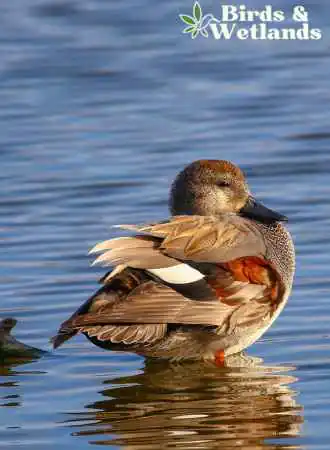
In North America, some of the most common duck species include the Mallard, American Black Duck, Northern Pintail, Wood Duck, Gadwall, Green-winged Teal, and the Blue-winged Teal. These ducks can be found in a variety of habitats such as lakes, ponds, rivers, and wetlands.
How many types of ducks are there in North America?
There are over 50 types of ducks in North America, which belong to a larger group of waterfowl called Anatidae. These ducks can be categorised into two main groups: dabbling ducks and diving ducks. Dabbling ducks feed on the surface of the water, while diving ducks dive beneath the surface to forage for food.
What is the rarest duck in North America?
The rarest duck in North America is the critically endangered Masked Duck. This small, elusive duck has a limited range and is primarily found in Mexico, Central America, and the Caribbean, with only occasional sightings in the southern United States.
What is the most beautiful duck in North America?
Beauty is subjective, but one of the most striking ducks in North America is the Wood Duck. The male Wood Duck has a colourful plumage, featuring iridescent green and purple feathers, a red eye, and a distinct white pattern around the face. The female is more subdued in colour but still quite attractive.
How many species of duck are there in North America?
There are over 50 species of ducks in North America, with a diverse range of sizes, shapes, and colours. These ducks inhabit various environments, from small ponds and wetlands to large lakes and rivers.
What is the largest duck in North America?
The largest duck in North America is the Common Merganser, also known as the Goosander. Males and females can reach lengths of up to 27 inches (68 centimetres) and have a wingspan of around 34 inches (86 centimetres). These diving ducks are known for their long, serrated bills and their ability to catch fish.
How do I identify a duck?
To identify a duck, observe its size, shape, colour, and behaviour. Pay attention to the patterns and colours of its plumage, especially on the head, neck, and wings. Look for distinguishing features like the shape of the bill, the size of the feet, and the type of tail.
Consider its habitat and location, as well as its swimming and feeding behaviours. A field guide or a birdwatching app can be a helpful resource for identifying ducks in the wild.

